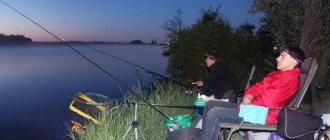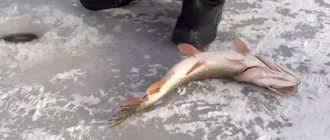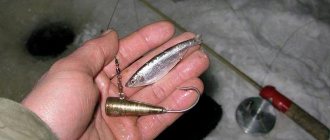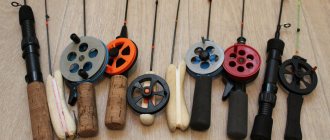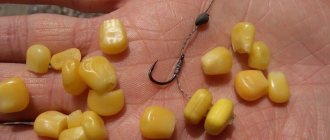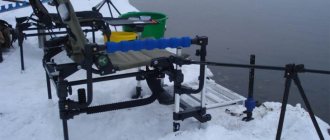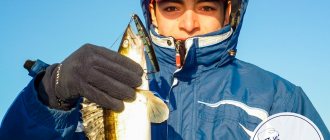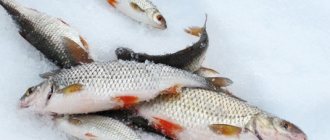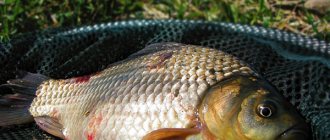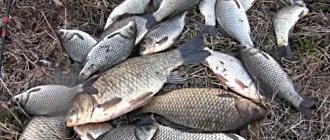Description of the gear and method of attaching it
Winter jigs for crucian carp are externally metal baits with a soldered hook of 2.5-4 sizes . In winter, fishing gear is mainly used in natural colors - lead, copper, brass. In the middle part of the tackle there is a hole intended for fishing line. It is through this hole that it is secured.
Perhaps the most correct and fairly reliable fastening in the case of attaching the tackle at different angles is achieved as follows: the fishing line is tied to the shank of the hook, after which it is necessary to ensure that the sting is facing upward. Vertical gear is attached differently.
When it comes to tying jigs, the best approach is to pre-prepare sets of various tackles with leashes of the appropriate thickness..
Thus, if there is a need for quick installation, they can be secured to the main line using a method better known as “loop to loop”.
Selection of fishing line corresponding to the weight of the tackle
Depending on the weight of the jig for winter fishing for crucian carp, you need to choose a fishing line. For greater convenience, we recommend that you familiarize yourself with the fishing line selection table .
Table No. 1
| Jig weight, grams | Line diameter, millimeters |
| From 0.1 to 0.3 | From 0.07 to 0.08 |
| From 0.3 to 0.5 | 0,1 |
| From 0.6 to 0.9 | 0,12 |
| From 1.0 to 1.5 | 0,15 |
| From 1.6 to 1.8 | From 0.17 to 0.18 |
| From 1.9 to 4.5 | From 0.2 to 0.23 |
This article will tell and show how to catch bream in winter at night.
In this article we will show you general techniques for catching bream in winter.
Which jigs are more profitable for catching crucian carp
For a successful outcome of all crucian carp fishing, you need to make sure that the behavior of the gear is completely natural . In this regard, its shape is not the last point when choosing gear. In fact, today there are a great many forms of jigs.
The most common jigs:
- Uralochka;
- wing;
- lentils;
- goat;
- oatmeal;
- ant;
- bug;
- drop;
- devil;
- boat;
- barrel;
- mormysh;
- spring.
Note that the most effective winter jigs for crucian carp are fairly light gear, the diameter of which does not exceed 2.5 millimeters . In most cases, the most popular material for making tackle for crucian carp is tungsten or lead.
Winter jigs:
- Lead pellet;
- Lentils, the lower part of which is made in a brass or silver shell;
- Lead lentils;
- Ant, made in brown, black, green or gray colors;
- Diamond-shaped, the lower part of which is lead or brass;
- Lead bug;
- Black, gray, brown, green droplets;
- Lead larva;
- Flat;
- Vertical;
- Cone-shaped;
- Lead barrel;
- Devil;
- Goat.
Catching perch in the fall with a jig, bait bait, spinning rod and fishing rod
Catching perch in the fall with a jig, bait, spinner and fishing rod is not an easy task. Read our article on how to fish correctly at this time.
Very often when fishing for perch in the fall, fishermen encounter problems. The fish stop biting where they were abundant yesterday. There are many explanations for this. For example, changes in atmospheric pressure and temperature or changes in wind direction. What affects the autumn perch bite? In the fall, the marten senses even the slightest weather changes in advance and swims away from the coastal zone. And as soon as the weather improves, the perches again, along with the adults, appear near the shore. With a slight wind, ripples appear on the water, which perch loves very much, because... you can move much more boldly in a body of water. But a factor such as blooming of a reservoir can cause the perch to stop biting in the fall.
Nozzles for jigs
If you are going to catch an excellent crucian carp, you need to know that the baits for its successful capture are mainly of animal origin. Thus, it will look quite good on the hook, and the fish will be caught with the classic bait of bloodworms, maggots and worms.
Crucian carp can be fussy eaters, and therefore you should resort to a combination of bloodworms and maggots . Note that the maggot is placed on the hook in the head area for a natural look, facilitating the quick capture of crucian carp. Various insects, as well as larvae of the appropriate size, can also be used as bait.
Mealworm, leech, dragonfly larva, bark beetle, grasshopper, burdock moth larva, fly and other animal baits . It is no secret that crucian carp in food in most cases prefers vegetable bait such as pearl barley. So, you can try to first plant boiled barley grain, and if you can’t catch fish in this way, start catching by using other, above-mentioned animal baits.
Are you interested in winter fishing for white bream? The article describes the main methods of catching this fish.
And in this article you will learn about effective methods for catching saberfish in winter.
Summer jig
Fishing with a summer jig (side nod) is one of the most interesting ways of fishing. In terms of activity and excitement it can be second only to spinning. It is good for catching perch, roach, bream, crucian carp, carp and many other types of fish.
Search for fish
With a side nod you can fish in any standing body of water, as well as in weak currents. This fishing is active, running. The fisherman is constantly on the move. One of the main tasks is to find a school of active fish.
There is always fierce food competition in a school of fish, and if you manage to find it, bites will follow one after another until the fish becomes wary and moves.
Here we will have to try to find her again and again, following on her heels. To keep the school in place, you can also use bait, but this is not always effective, since the fish moves in all layers of water and may not respond to food lying on the bottom. Moreover, in this case we become tied to one place.
The next task is to decide on the fishing area. Find places on the reservoir where fish come out to feed. With a side nod you can fish from the shore, wade or from a boat. Fishing from the shore is possible only in rare cases - as a rule, this is fishing from dams, piers, bridges, etc.
Wading fishing in waders is much more interesting. Fishing begins immediately after the ice melts. The largest specimens are often found at this time. But the water is still very cold, so be careful not to get too cold! Neoprene waders are best.
Under regular waders you should wear warm (as for winter fishing) pants and socks. We fish the coastal zone in waders. Our task is to decide where to start and where to move. Important factors here are: Wind. A weak wind is our ally.
When there is wind, the water is mixed evenly, which has a positive effect on the bite. In so-called “turbulent” water, it is much easier to get close to the fish in waders or on a boat; Only when wading fishing, enter the water carefully. If the water is clear, then the intended prey is cautious.
Enter with stops every 2-3 steps, trying not to raise the mud from the bottom. It is desirable that the wave be breaking - in this case the fish comes much closer to the shore.
It is inconvenient to fish with a side wind - it bends the rod and line. It is impossible to fish in strong winds - there is a risk of the rod breaking. With little or no wind, the fish are less active and stand quite far from the shore. Therefore, in calm weather we often cannot reach it. Bottom relief.
Long, lightly overgrown spits of grass are very attractive for wading fishing. All the fish come out here to feed. And we can follow them far enough and get close to it, and the vegetation camouflages the fisherman. Fishing can be quite successful if you manage to go behind a long wall of reeds or reeds.
Very interesting are the various changes in the bottom topography (pits, “navels”), as well as rubble and snags. In addition, trees that have fallen into the water or are leaning low over it should attract your attention. Especially if you are fishing with a jig on a river.
Actively search for fish. You can start from the shallows and move towards the depth (or vice versa), then return to places where there were more bites.
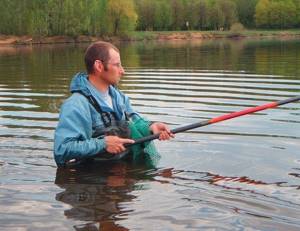
Season and time of day
Spring is perhaps the best time for a summer jig. At this time, you can get to the pre-spawning zhor. The fish gather in large schools and become less timid, biting aggressively, often throughout the day. In the spring, the fish run aground up to 1 m, and very often they are perfectly caught with a jig.
At the beginning of summer there is a sharp attenuation of the bite. The fish is exhausted, sick and therefore is unlikely to chase the jig. At this time, it would be useful to use a replant (worm, bloodworm, maggot, etc.).
There are many factors that influence fish biting on a jig. The mass emergence of insects is an excellent moment for fishing with a side nod (which cannot be said about float fishing). Fish can be caught throughout the entire water column, very often from the very surface. The fish can take the jig all day long.
But, as a rule, in approaches - from one to several - the warmer the water, the more different food there is in it and the shorter and less frequent bursts of activity. There is often a morning exit at dawn and 1–2 hours after (typical exit in very clear water).
There are some good daytime outings, especially with a steady moderate wind in the surf. There is a direct dependence of the bite on the temperature, transparency and illumination of the water.
In cold transparent water the best bite is in cloudy weather and, conversely, in cloudy water - in sunny weather. Throughout the summer, fish continue to be caught well with a jig.
Only in small, stagnant bodies of water, as a rule, the bite “cuts out.” When they are warmed up, water and algae bloom wildly. This has an adverse effect on the bite.
In reservoirs, large lakes and quarries, large bream, crucian carp, carp and roach often approach the shore in early and mid-summer. Sometimes in stable warm weather the fish come out to the shallowest areas. When the weather worsens, it retreats to depth. As the water cools - late summer - autumn - the fish also begin to move closer to depth.
At this time, it is important to fish from a boat and wade if there are sufficiently deep places within reach. Throughout the spring-summer-autumn season, fishing from a boat gives good results.
When it gets cold, you can’t do without a boat, since the fish often “flip off” quite far from the shore, continuing to feed. At this time, you can catch a respectable fish with a jig in a large lake or reservoir. It stays at a considerable depth closer to the holes, but from a boat you can continue to catch it more or less successfully.
At this time, a “steam locomotive” made of “devils” or jigs works well. Fish releases in autumn become shorter-lived. The bites are weaker and closer to the bottom. You can also see bites on small ponds and lakes in the fall. Perch or rotan grab the jig quite greedily at this time. They can also be caught offshore! This is what a lover of active fishing needs.

Fishing from a boat
When fishing from a boat with a jig, we do not depend on the fish approaching the shore within reach (as when fishing by wading and from the shore itself). From a boat we can “process” the entire body of water - from coastal shallows to the deepest holes. The fish is much less afraid of a boat than of an angler standing in the water.
In these places you can try to collect fish using additional food. By the way, this can also be done when fishing by wade. Usually 2-3 fist-sized balls are thrown. It is not the quantity that is important, but the regularity.
Feeding should not be very rich. For example, basic unified food and ballast (clay, sand, earth). A good option is feeding with the addition of maggot larvae and bloodworms.
When fishing with a jig in clear water, you should try to simply muddy the water in the fishing area - throw in a few small lumps of earth, sand, or clay. When fishing from a boat, you need to anchor very “firmly”.
The boat should not spin around its axis, wag its bow or stern. Our long rod in the wind or when fishing can, like a lever, move the boat from cargo and anchors. Fishing in a very strong wind, on a high wave, nodding becomes impossible. When fishing from a boat, be prepared to change anchorages frequently.
Standing securely on two anchors (and getting rid of them) is quite a difficult task. When searching for fish, it is a good idea to watch the water surface. Chains of small bubbles or frequent bursts can give away the desired school (bream, crucian carp, roach, etc.).
Note! You should always have several reels (rigs) with different fishing lines and nods, since in one place you may encounter bites from different fish (type and size). It is impossible to select equipment for catching medium-sized roach and large bream or crucian carp at the same time, although they can be caught interspersed. We need to decide on the object of fishing.
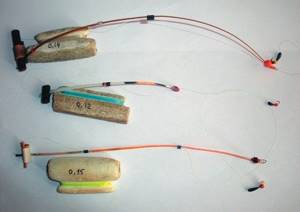
Tackle
For fishing with a side nod, two types of rod equipment are most often used: - a blind rod, which looks like a fly rod with a foam reel mounted in its upper part; - running, consists of a rod with rings, fishing line wound on a reel and a nod, on which small wire rings are also installed.
When fishing with blind tackle, we constantly move the telescopic rod apart and move it. If the working line release is significantly smaller than the rod, after hooking you have to collect it in order to reach the fish. This must be done very carefully, without giving any slack.
But if you have a very large fish or you are fishing with a very thin line, you will have to fish with an unassembled rod. Otherwise you risk breaking it. Using a tackle with a reel, the angler, after hooking, brings the fish out with the help of a reel. If the line release is very short, it gently lifts the fish up and at the same time releases the line from the reel without giving any slack.
The rings on the rod and guard should perfectly pass the fishing line (preferably SiC or analogues). When fishing with running tackle, the rod does not get scratched or rubbed due to constant handling. You can safely catch very large fish on a thin line using the reel drag.
But blind tackle is more mobile when fishing and changing equipment, simple and lighter. If you purposefully intend to catch large fish, be sure to use a rod equipped with a reel. Typically, a fishing rod is used from 5 to 10 m long, as thin as possible in the butt, but at the same time quite rigid.
The rod should not bend too much in crosswinds and should not bend under its own weight. The reel should be of minimal size (so that there is less “sail” in the wind) and lightweight (made from foam plastic, cork). Thin fishing line (0.1–0.15 mm) should be as strong and transparent as possible.
It is very difficult to choose a nod or find a compromise, since the side nod should be hard, but at the same time play well with the jig and mark all the bites. The bites are quite strong, so you should give preference to hard nods - they are less afraid of the wind.
At the very tip of the nod, a small ball or cylinder of 5–10 mm is usually attached for better visibility. Material for the nod: lavsan or metal plate.
When fishing with a side nod, various nozzleless jigs are used: uralks, drops, ants, devils, goats. Some fishermen use tandems of two jigs - a devil and a pendant (hook with beads).

Fishing technique
Fishing with a side nod is usually carried out at shallow and medium depths. At depths not exceeding 3 m, the jig can be carried from the bottom to the surface, thus fishing the entire thickness of the water. When you find a horizon with the maximum number of bites, you need to work with the tackle at this depth (if it is near the bottom, then do not lift it high, but if from the middle to the surface, then you can reel in the required amount of fishing line).
However, the situation can change at any moment. Fish can constantly move in the water column, especially when wind, light, and temperature change. We carry out the jig from the bottom up (from the bottom) and from the top down (from the surface). When fishing with a side nod, even with well-functioning gear, achieving good play with the jig (frequency and amplitude of oscillation) is very difficult or even almost impossible.
A very long rod sways when trying to set the jig to small vibrations. The wind gets in the way - when you lift the jig, it blows out the line and bends the rod. Therefore, the most common way to play is to rise evenly from the bottom to the surface without hesitation.
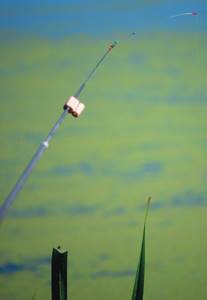
The pace of the retrieve is quite fast, since we are fishing with a jig without an attachment. Jig hooks are equipped with beads, membranes, pieces of foam rubber or rubber. The next method is a slow rise up with small, frequent vibrations and a faster descent down without vibrations. Or vice versa - the ascent is fast without hesitation and the descent is slow. The frequency and amplitude of vibrations are constantly changing.
When lifting a jig, it is sometimes a good idea to do it diagonally to the surface. When lowering, it can be useful to hold the jig motionless at the bottom for a couple of seconds. You can make stops with small or wide fluctuations. These elements can be used in any wiring.
There is a fear that the fish “get used” to the jig and its game, so anglers achieve maximum success by changing both the game and the jig itself (color, shape, size) from time to time. All this is honed solely by fishing practice. Bites on a jig can look like a sharp bend of the nod, its stop or rise up, but sometimes even a very large fish only slightly touches it, while the guard trembles slightly - you need to “cut” all the bites!
It often happens that there are continuous empty bites. It doesn't have to be a small thing. It may be necessary to change the game or the jig itself, or maybe give the fishing spot a temporary “rest.” It is also useful to take a short break from fishing or move far to the side to find another working point.
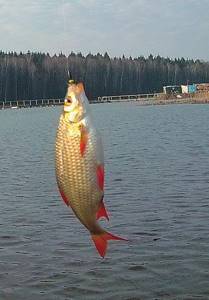
You can then go back or continue the active search. One summer I had to fish in rather unusual conditions for a side nod. I found out that there was crucian carp in one pond, but only early in the morning. Without calculating the time, I arrived at that pond in complete darkness. I see an equipped jig standing by the water, waiting for dawn.
He confirmed the “information” that yesterday in the morning 1-2 hours he caught several dozen decent crucian carp. However, our morning was cloudy, and dawn did not come. My colleague couldn’t stand it, he went into the water in his boots and, in almost complete darkness, began “dipping the jig.”
I took this with humor, but after a few minutes I saw that he was dragging fish. After the fifth crucian carp he joined this fisherman. I couldn’t understand how he controlled the wiring and saw the bite almost in the dark. The jig fisherman explained that he let go of a meter of fishing line and made a lift to the top - and the bite “hits” his hand. I also managed to catch several crucian carp this way before dawn.
After this incident, I repeatedly tried to fish in the dark and sometimes very successfully. I even adapted to see the nod. I let out more line so that the rod always “looked” upward at an angle of 30˚. Against the background of a clear sky, the dark nod was sometimes clearly visible in the morning twilight.
To make the nod more visible, you can bend (twist) a small narrow part almost perpendicularly - this way the nod will turn towards our eyes with its entire width, and not with a thin edge. Another example of non-standard fishing conditions - one of my “specialist” friends fishes with a jig from spring to late autumn on a small river near Moscow. This part of the river has a lot of its own large fish, plus there is a channel - an outlet from the fish farm.
For some reason, fish often escape into the river from the farm and stop in nearby bays. The comrade, apparently, had “cut through” and began to pick up the keys to the fish. I don’t know how much time and effort it cost him, but now he regularly catches bream up to 3 kg and carp up to 5 kg there.
He built a tackle that was “terrible” in terms of power: a thick domestic “telescope” with a cut off tip, a spinning reel, a fishing line with a diameter of 0.2 mm and a huge jig with hook No. 10 (according to domestic numbering). In each bay he built a pen where he brings fish, since in an ordinary place it is almost impossible to put such monsters in a landing net for one. In this way he catches several trophies a day!
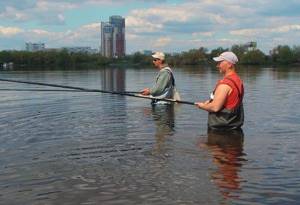
Selecting an “edible” jig is a very difficult job. You can rely on the experience of others or experiment yourself in choosing the shape, color, size of the jig and its equipment. Lead (unpainted), black, shiny jigs with hooks equipped with small beads (1–3 mm) work well when catching perch, bream, roach, and crucian carp.
The color and size must match the fish, depth, and lighting. The lighter the water, the darker the jig and beads on it should be - and vice versa. You will also have to struggle with choosing a size. There is no ideal size. Fish can perfectly grab a huge jig (more than 10–12 mm), but not notice a small one (5–7 mm). With the size of beads on the hook, it is better not to “bend” and use small and medium (as in winter).
Bead colors: yellow, white, cherry, ruby, blue. It happens that adding a piece of foam rubber or rubber has a positive effect. Fishing with a side nod with natural baits - bloodworms, maggots, etc., as well as with complementary foods, is not interesting: the dynamics and sportiness of fishing disappear. It’s much more interesting to find, pick up a game, a jig, and go ahead. But that's just my opinion.
This is interesting! Shallows overgrown with grass are a good place for fishing with a side nod in the first half of summer, when spawning of crucian carp and other fish species occurs here, as well as a massive emergence of aquatic insects. Closer to autumn, large fish leave these areas.
Catching crucian carp with a jig
We attach the bloodworm to the hook of the jig, and then lower the “charged” tackle into the water, trying to imitate the natural fall of the bait. The gear is lowered slowly, with stops, and there should be no slack in the line . Raise the rod as you cast.
To successfully catch crucian carp, the method of smooth and slow lifting of the gear with periodic short stops is effectively used. Also, when the jig stops, you can play with it a little, thereby trying to attract potential prey.
Wiring from side to side is a good technique for attracting crucian carp . This method of fishing for crucian carp involves slow movements of the bait, periodically raising it by several centimeters. If the nod of the rod begins to tremble little by little, the fish is trying the bait. You can understand that a crucian carp has been caught and is on the hook by two simple signs: the nod periodically, or it bends sharply.
In this case, it is necessary to hook gently , since otherwise you risk being left without a catch. This is explained by the fact that the lips of crucian carp are not able to withstand loads due to their fragility.
How to catch crucian carp in the summer with a jig
First you need to throw the bait into the water. You can let the jig immediately sink to the bottom, but it is better to do this smoothly by raising the rod above the water. Many experienced fishermen believe that the gradual immersion of such bait into the water attracts crucian carp more.
As soon as the jig reaches the bottom, it is best to take a short break. Lasting a few seconds. Then start playing with a jig. Remember that in summer crucian carp are least responsive to horizontal movements of the bait.

Some practice is required to effectively fish with a jig.
Therefore, try to lift the fishing rod up so that the jig comes off the bottom by 5-7 cm and falls back to it. In this case, the ascent speed should be very low. Approximately 1-2 cm per second. You also need to make stops so that the bait lies on the bottom for some time without moving.
The most effective wiring in autumn and spring is horizontal. It is she who consistently attracts crucian carp at this time. The bait rises slightly above the bottom and is slowly moved from side to side. In summer, in addition to the vertical movements of the jig, fish respond well to diagonal upward movements of the bait and slight vibrations of the nod.
True, sometimes in the summer crucian carp are caught using the “perch” version of the bait. Why he suddenly begins to be attracted to sharp rises with high amplitude is a real mystery.
But large fish rarely respond to the active play of the jig. Keep this in mind if you go fishing for trophy specimens. In addition, summer fishing for crucian carp with a jig can also include the use of different baits. This allows you to interest the fish and provoke a bite. Especially if fishing takes place in a silted reservoir or in areas with dense vegetation.
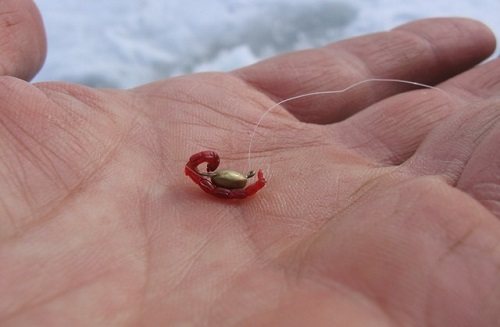
When fishing with a jig, you can use bloodworms as bait.
To catch crucian carp in the summer using a jig, animal, plant and artificial baits are used. It could be:
- pearl barley;
- bloodworm;
- maggot;
- insects;
- piece of worm;
- foam ball;
- foam rubber, etc.
